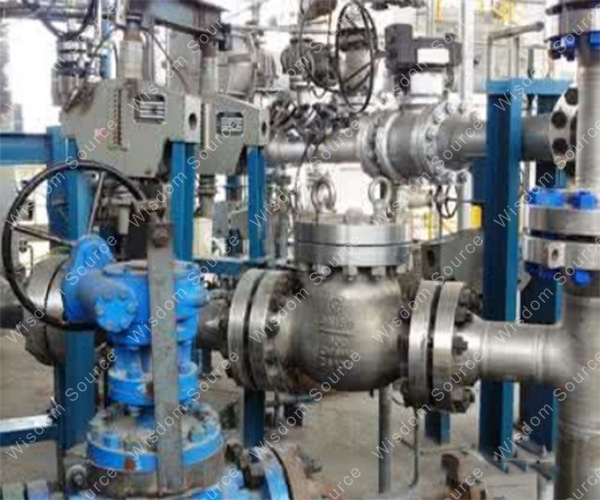The Performance Of Cast Titanium Alloy And Its Application In The Field of Valves
The Performance Of Cast Titanium Alloy And Its Application In The Field of Valves
With its low density (4.5g/cm3), high specific strength (3 times the strength/density ratio of super steel), excellent corrosion resistance (can withstand seawater, strong acids and other media), and excellent extreme temperature adaptability (-253℃ to 600℃), titanium alloy has become a strategic material in the modern industrial field. Especially in valve manufacturing, casting titanium alloys has realized the high-performance production of complex structural parts through precision molding technology. This paper takes the most widely used ZTC4 (Ti-6Al-4V) alloy as an example to analyze its technical characteristics and innovative practices in high-end valve fields such as shipbuilding and aerospace.
1. Technical characteristics and classification system of cast titanium alloy
1) Alloy classification and performance matrix
Cast titanium alloys can be divided into α type (such as ZTA1), β type (such as TB6) and α+β duplex type (such as ZTC4) according to the microstructure, and their properties are significantly different (see Table 1). Taking ZTC4 as an example, its Al/V element synergistic strengthening mechanism makes it both high strength (tensile strength≥895MPa) and good plasticity (elongation≥10%), while maintaining stable fracture toughness at 350℃, it has become the material of choice for medium temperature and high pressure conditions.
Comparison Of Properties Of Typical Cast Titanium Alloys
Alloy
Grade |
Type |
Tensile Strength
(MPa) |
Yield Strength
(MPa) |
Applicable
Temperature Range |
Core
Application Scenarios |
ZTA1 |
α |
345 |
275 |
<300℃ |
Corrosive Medium
Valves |
ZTC4 |
α+β |
895 |
825 |
<350℃ |
Marine/Air High
Voltage System |
TB6 |
β |
1100 |
1000 |
450℃ |
High-Temperature
Special Valves |
2) Lightweight and functional advantages
Compared with traditional stainless steel (density 7.9 g/cm3), titanium alloy can reduce weight by up to 45%, and its pitting resistance is increased by 5-10 times. This feature directly reduces the load of the piping system in marine valves, and significantly improves the thrust-to-weight ratio in the aviation field. For example, the valve body made of ZTC4 has a 42% weight reduction compared to 316L stainless steel, and its life span is more than 3 times longer.
2. Analysis Of Cutting-Edge Application Scenarios Of Titanium Alloy Valves
Valves for deep-sea ships: the technical benchmark for corrosion protection
1) Technical pain points: Seawater Cl⁻erosion causes copper alloy valves to fail in 2-5 years, and maintenance costs account for more than 40% of the pipeline system.
2) Titanium alloy solution: The Ti80 (Ti-6Al-3Nb-2Zr-1Mo) triple eccentric butterfly valve developed by CSSC 725 Research Institute, through the β-phase stabilization design, achieves zero corrosion in seawater with a high pressure of 50 MPa and a flow rate of 12 m/s, and its life span exceeds 25 years.
3) The all-titanium piping system of the Russian "God of the North Wind"-class nuclear submarine, including more than 1,200 titanium alloy valves such as globe valves and ball valves, reduces weight by 30 tons and realizes maintenance-free throughout its life cycle.
Aerospace Valves: A Revolution in Reliability in Extreme environments
1) High-temperature fuel system: Boeing 787 adopts Ti-6242S alloy fuel regulating valve, which can withstand the impact of exhaust gas at 650℃. Compared with nickel-based alloys, it reduces weight by 38% and improves fuel efficiency by 2.1%.
2) Low-temperature propulsion system: The liquid oxygen valve of the DragoN spacecraft uses Ti-5Al-2.5Sn ELI alloy, which maintains 85% impact toughness at -253℃, and successfully passed 2000 low-temperature cycle tests.
3) Breakthrough in cost control: Precision casting technology has reduced the production cost of titanium valves by 60% compared with forged parts. The American PCC Company has achieved 95% near-net-shape casting of valve bodies with a diameter of less than 600mm.

3. Industrialization Trends And Challenges Of Titanium Alloy Valves
1) Technology Upgrade Direction:
Developed Ti-Al-Mo-Si series 600℃ grade heat-resistant alloy to break through the thermal barrier of aviation engine control valve
Promote 3D printing, optimize the valve cavity structure, and realize the efficiency improvement of the flow channel and the thinning of the wall thickness by 30%
2) Industrialization Bottleneck:
The porosity of castings needs to be reduced from the current 0.8% to below 0.3% to meet the ASME B16.34 high pressure standard
The cost is still 4-6 times that of carbon steel valves, and the cost needs to be reduced by 20%-30% through short-process smelting (EBCHM process).%
With the integration of precision casting, additive manufacturing and other technologies, cast titanium alloy valves are penetrating from special fields to trillion-level markets such as petrochemical and nuclear power.
According to GVR's forecast, the global titanium valve market will reach US44.8 billion in 2025, of which China accounts for more than 35%. In this material-driven industrial revolution, mastering the development of high-performance titanium alloys and the manufacturing capabilities of complex components will become the core barrier for valve companies to break through the high-end market.
